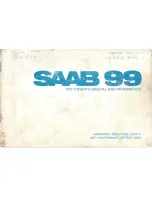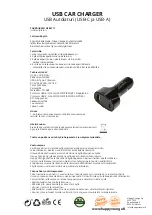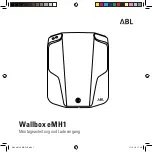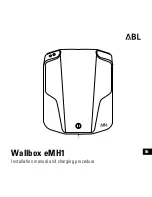
Cooling system
The cooling system is of pressurised type
and includes a front mounted crossflow
radiator, belt-driven water pump, temperature-
sensitive thermo-viscous fan (on DOHC
models, an electrically-operated cooling fan is
fitted, operated by a switch in the thermostat
housing), wax type thermostat, and an
expansion and degas tank.
The radiator matrix is of copper and brass
construction and the end tanks are of plastic.
On automatic transmission models the right-
hand side end tank incorporates the
transmission oil cooler.
The thermostat is located behind the water
outlet elbow at the front of the cylinder head
on OHC models, and on the front of the water
pump on V6 models. Its purpose is to ensure
rapid engine warm-up by restricting the flow of
coolant in the engine when cold, and also to
assist in regulating the normal operating
temperature of the engine.
The expansion tank incorporates a pressure
cap which effectively pressurises the cooling
system as the coolant temperature rises,
thereby increasing the boiling point of the
coolant. The tank also has a further degas
function. Any accumulation of air bubbles in
the coolant, in particular in the thermostat
housing and the radiator, is returned to the
tank and released in the air space thus
maintaining the efficiency of the coolant.
On models fitted with the auxiliary warning
system, the expansion tank contains a level
sensor which operates a warning light if the
coolant level falls significantly.
When the engine is started from cold, the
water pump circulates coolant around the
cylinder block, cylinder head(s) and inlet
manifold. The warm coolant passes through
the automatic choke housing (when
applicable) and through the heater matrix
before returning to the engine. As the coolant
expands, the level in the expansion tank rises.
Circulation of coolant through the radiator is
prevented while the thermostat is shut. When
the coolant reaches the predetermined
temperature the thermostat opens and hot
water passes through the top hose to the top
of the radiator. As the water circulates down
through the radiator, it is cooled by the
passage of air past the radiator when the car is
in forward motion, supplemented by the action
of the thermo-viscous fan when necessary.
Having reached the bottom of the radiator, the
water is now cool and the cycle is repeated.
Circulation of water continues through the
expansion tank, inlet manifold and heater at all
times; the heater temperature control being by
an air flap.
The thermo-viscous fan is controlled by the
temperature of air behind the radiator. When
the air temperature reaches a predetermined
level, a bi-metallic coil commences to open a
valve within the unit and silicon fluid is fed
through a system of vanes. Half of the vanes
are driven directly by the water pump and the
remaining half are connected to the fan blades.
The vanes are arranged so that drive is
transmitted to the fan blades in relation to the
drag or viscosity of the fluid, and this in turn
depends on ambient temperature and engine
speed. The fan is therefore only operated when
required, and compared with direct drive type
fan represents a considerable improvement in
fuel economy, drivebelt wear and fan noise.
Air conditioning
Air conditioning is fitted as standard on
Scorpio models and is optionally available on
some other models. In conjunction with the
heater, the system enables any reasonable air
temperature to be achieved inside the car, it
also reduces the humidity of the incoming air,
aiding demisting even when cooling is not
required.
The refrigeration side of the air conditioning
system functions in a similar way to a
domestic refrigerator. A compressor, belt-
driven from the crankshaft pulley, draws
refrigerant in its gaseous phase from an
evaporator. The compressed refrigerant
passes through a condenser where it loses
heat and enters its liquid phase. After
dehydration the refrigerant returns to the
evaporator where it absorbs heat from air
passing over the evaporator fins. The
refrigerant becomes a gas again and the cycle
is repeated.
Various subsidiary controls and sensors
protect the system against excessive
temperature and pressures. Additionally,
engine idle speed is increased when the
system is in use to compensate for the
additional load imposed by the compressor.
Precautions
Antifreeze mixture
Antifreeze mixture is poisonous. Keep it out
of reach of children and pets. Wash splashes
off skin and clothing with plenty of water.
Wash splashes off vehicle paintwork to avoid
discolouration.
Antifreeze/water mixture must be renewed
every two years to preserve its anti-corrosive
properties. In climates where antifreeze
protection is unnecessary, a corrosion
inhibitor may be used instead - consult a Ford
dealer. Never run the engine for long periods
with plain water as coolant. Only use the
specified antifreeze, as inferior brands may not
contain the necessary corrosion inhibitors, or
may break down at high temperatures.
Antifreeze containing methanol is particularly
to be avoided, as the methanol evaporates.
The specified mixture is 45 to 50%
antifreeze and 50 to 55% clean soft water (by
volume). Mix the required quantity in a clean
container.
Air conditioning refrigerant
Although the refrigerant is not itself toxic, in
the presence of a naked flame (or a lighted
cigarette) it forms a highly toxic gas. Liquid
refrigerant spilled on the skin will cause
frostbite. If refrigerant enters the eyes, rinse
them with a dilute solution of boric acid and
seek medical advice immediately.
In view of the above points, and of the need
for specialised equipment for evacuating and
recharging the system, any work which
requires the disconnection of a refrigerant line
must be left to a specialist.
Do not allow refrigerant lines to be exposed
to temperatures above 110°C (230°F) - eg
during welding or paint drying operations and
do not operate the air conditioning system if it
is known to be short of refrigerant, or further
damage may result.
1 General information and
precautions
3•2 Cooling, heating and ventilation systems
Torque wrench settings
Nm
lbf ft
Radiator lower mountings . . . . . . . . . . . . . . . . . . . . . . . . . . . . . . . . . . . .
8 to 12
6 to 9
Thermostat housing bolts:
SOHC, DOHC and 2.8 litre V6 . . . . . . . . . . . . . . . . . . . . . . . . . . . . . .
17 to 20
13 to 15
2.4 & 2.9 litre V6 . . . . . . . . . . . . . . . . . . . . . . . . . . . . . . . . . . . . . . . . .
7 to 10
5 to 7
Water pump bolts:
SOHC, M8 bolts . . . . . . . . . . . . . . . . . . . . . . . . . . . . . . . . . . . . . . . . .
17 to 21
13 to 16
SOHC, M10 bolts . . . . . . . . . . . . . . . . . . . . . . . . . . . . . . . . . . . . . . . .
35 to 42
26 to 31
DOHC . . . . . . . . . . . . . . . . . . . . . . . . . . . . . . . . . . . . . . . . . . . . . . . . .
21 to 28
16 to 21
2.8 litre V6 . . . . . . . . . . . . . . . . . . . . . . . . . . . . . . . . . . . . . . . . . . . . . .
9 to 13
7 to 10
2.4 & 2.9 litre V6 . . . . . . . . . . . . . . . . . . . . . . . . . . . . . . . . . . . . . . . . .
7 to 10
5 to 7
Water pump pulley bolts . . . . . . . . . . . . . . . . . . . . . . . . . . . . . . . . . . . . .
21 to 26
16 to 19
Water pump/alternator drivebelt tensioner bolt (DOHC) . . . . . . . . . . . .
70 to 97
52 to 72
Fan-to-viscous clutch bolts:
SOHC . . . . . . . . . . . . . . . . . . . . . . . . . . . . . . . . . . . . . . . . . . . . . . . . .
8 to 10
6 to 7
V6 . . . . . . . . . . . . . . . . . . . . . . . . . . . . . . . . . . . . . . . . . . . . . . . . . . . .
17 to 23
13 to 17
Fan shroud bolts . . . . . . . . . . . . . . . . . . . . . . . . . . . . . . . . . . . . . . . . . . .
8 to 11
6 to 8
Cylinder block drain plug . . . . . . . . . . . . . . . . . . . . . . . . . . . . . . . . . . . .
21 to 25
16 to 18
Summary of Contents for Granada 1985-1994
Page 42: ...1 22 Notes...
Page 102: ...2C 22 Notes...
Page 136: ...4 24 Notes...
Page 176: ...11 14 Notes...
Page 196: ...12 20 Notes...
Page 221: ...Wiring diagrams WD 1 WD Diagram 16 Power operated sliding roof...
Page 222: ...WD 2 Wiring diagrams Diagram 2 Power distribution...
Page 223: ...Wiring diagrams WD 3 WD Diagram 2 Power distribution continued...
Page 224: ...WD 4 Wiring diagrams Diagram 3 Charge start and run Part 1...
Page 225: ...Wiring diagrams WD 5 WD Diagram 3 Charge start and run Part 1 continued...
Page 226: ...WD 6 Wiring diagrams Diagram 3A Charge start and run Part 2...
Page 227: ...Wiring diagrams WD 7 WD Diagram 3A Charge start and run Part 2 continued...
Page 228: ...WD 8 Wiring diagrams Diagram 4 Engine management 1 8 litre...
Page 229: ...Wiring diagrams WD 9 WD Diagram 4 Engine management 1 8 litre continued...
Page 230: ...WD 10 Wiring diagrams Diagram 4A Engine management 2 0 litre carburettor...
Page 231: ...Wiring diagrams WD 11 WD Diagram 4A Engine management 2 0 litre carburettor continued...
Page 232: ...WD 12 Wiring diagrams Diagram 5 Engine management 2 0 litre fuel injection...
Page 233: ...Wiring diagrams WD 13 WD Diagram 5 Engine management 2 0 litre fuel injection continued...
Page 234: ...WD 14 Wiring diagrams Diagram 5C Engine management 2 8 litre...
Page 235: ...Wiring diagrams WD 15 WD Diagram 5C Engine management 2 8 litre continued...
Page 236: ...WD 16 Wiring diagrams Diagram 7A Exterior lighting...
Page 237: ...Wiring diagrams WD 17 WD Diagram 7A Exterior lighting continued...
Page 238: ...WD 18 Wiring diagrams Diagram 9 Signalling and warning systems...
Page 239: ...Wiring diagrams WD 19 WD Diagram 9 Signalling and warning systems continued...
Page 240: ...WD 20 Wiring diagrams Diagram 10 Interior lighting...
Page 241: ...Wiring diagrams WD 21 WD Diagram 10 Interior lighting continued...
Page 242: ...WD 22 Wiring diagrams Diagram 12 Wipers and washers...
Page 243: ...Wiring diagrams WD 23 WD Diagram 12 Wipers and washers continued...
Page 244: ...WD 24 Wiring diagrams Diagram 14 Central locking system...
Page 245: ...Wiring diagrams WD 25 WD Diagram 14 Central locking system continued...
Page 246: ...WD 26 Wiring diagrams Diagram 15 Power operated windows...
Page 247: ...Wiring diagrams WD 27 WD Diagram 15 Power operated windows continued...
Page 248: ...WD 28 Wiring diagrams Diagram 21 ABS...
Page 249: ...Wiring diagrams WD 29 WD Diagram 21 ABS continued...
Page 250: ...WD 30 Wiring diagrams Diagram 23 Auxiliary warning system...
Page 251: ...Wiring diagrams WD 31 WD Diagram 23 Auxiliary warning system continued...
Page 252: ...WD 32 Wiring diagrams Diagram 29 Radio cassette player and associated circuits typical...
Page 254: ...WD 34 Wiring diagrams Diagram 11 Heater blower...
















































